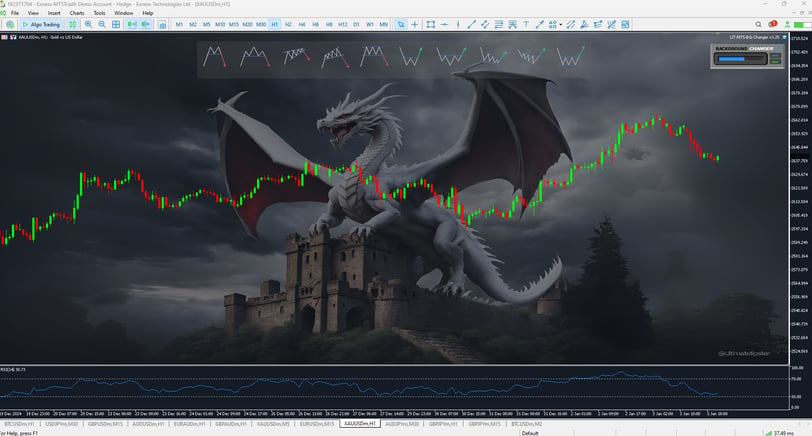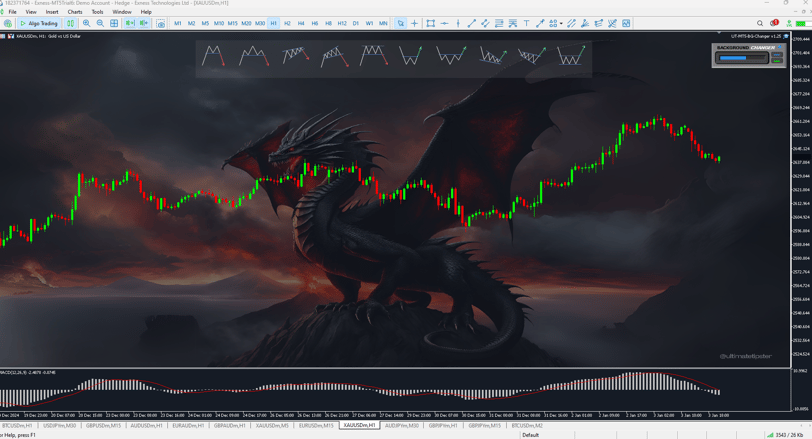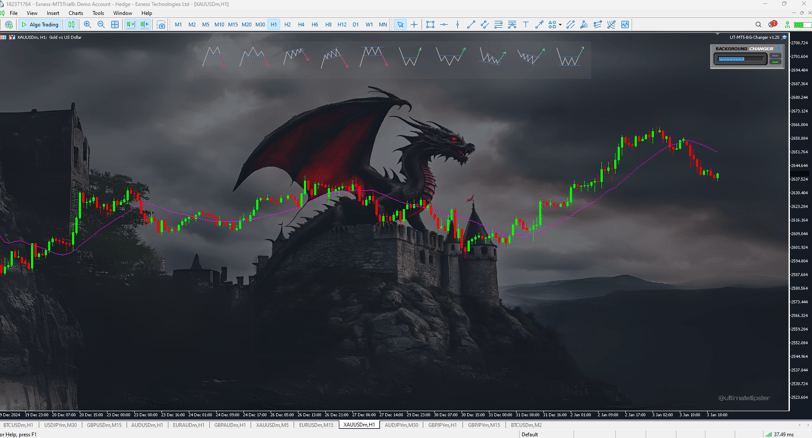Mastering Trading: How to Use RSI, MACD, and Moving Averages for Success
Kenji Murakami
11/25/20249 min read


Introduction to Technical Indicators
In the realm of trading, technical indicators serve as vital tools that assist traders in analyzing price movements and determining the optimal points for entering or exiting trades. These indicators, derived from historical price and volume data, allow for a quantified approach to assessing market conditions and trends. Among the myriad of technical indicators available, three stand out due to their effectiveness: the Relative Strength Index (RSI), Moving Average Convergence Divergence (MACD), and Moving Averages. Understanding these indicators is essential for any trader aiming to enhance their strategy and decision-making process.
The Relative Strength Index (RSI) is a momentum oscillator that measures the speed and change of price movements. It ranges from 0 to 100 and is primarily used to identify overbought or oversold conditions in a market. Typically, an RSI above 70 suggests that an asset is overbought, while an RSI below 30 indicates that it is oversold. Traders utilize these signals to anticipate potential price corrections, making it a crucial component of their trading toolkit.
Next, the Moving Average Convergence Divergence (MACD) is an indicator that reveals changes in the strength, direction, momentum, and duration of a trend in a stock's price. It consists of the MACD line, signal line, and histogram, providing insights into bullish and bearish market conditions. When used effectively, MACD can help traders identify potential reversals and confirm trends.
Lastly, Moving Averages are widely regarded as fundamental indicators that smooth out price data to identify the direction of the trend. By calculating the average price over a specific period, traders can gain clarity on market trends, making it easier to make informed decisions. An integration of these indicators not only enhances a trader's strategy but also lays the groundwork for successful trading tactics in varying market conditions.
Understanding RSI: The Relative Strength Index
The Relative Strength Index (RSI) is a widely utilized momentum oscillator that gauges the speed and change of price movements. Developed by J. Welles Wilder, the RSI is calculated using the formula RSI = 100 - (100 / (1 + RS)), where RS represents the average of upward price changes divided by the average of downward price changes over a specified period, typically 14 days. This calculation results in a value that ranges between 0 and 100, serving as a valuable tool for traders seeking to assess market momentum.
One of the critical aspects of the RSI is its ability to identify overbought and oversold conditions in the market. An RSI value above 70 generally indicates that an asset may be overbought, suggesting that prices could be due for a correction. Conversely, an RSI below 30 signifies that an asset might be oversold, indicating a potential rebound in price. These thresholds act as critical reference points for traders, allowing them to make informed decisions based on prevailing market conditions.
It is essential to note that while the RSI is a robust tool, it should not be used in isolation. Combining its signals with other indicators can significantly enhance trading strategies. For instance, a trader might observe an RSI reading above 70, but if the price action also shows strong resistance levels, the trader may decide to wait for confirmation before initiating a sell position. Furthermore, some traders employ divergence analysis, where they compare the movement of the RSI against the price of an asset; a discrepancy in these movements can signal potential market reversals.
Real-time examples illustrate the practical application of RSI in trading decisions. For instance, a trader monitoring a stock may notice an RSI spike above 70 during a market rally. Faced with this indicator, the trader can decide whether to take profits or defer buying more shares until the market corrects itself. Likewise, when the RSI drops below 30, a trader may opt to enter a position, anticipating a rebound. Ultimately, the RSI serves as a valuable indicator, complementing a comprehensive trading strategy.


Exploring MACD: Moving Average Convergence Divergence
The Moving Average Convergence Divergence (MACD) is a popular technical indicator used by traders to gauge momentum and trend dynamics in financial markets. This tool comprises three main components: the MACD line, the Signal line, and the Histogram. Together, these elements assist traders in identifying potential buy and sell opportunities through analysis of trend reversals and shifts in momentum.
The MACD line is derived from the difference between two exponential moving averages (EMAs). Typically, traders utilize the 12-period EMA and the 26-period EMA to calculate this line. When the MACD line crosses above the Signal line, which is a 9-period EMA of the MACD line, it may signal a potential buying opportunity. Conversely, when the MACD line crosses below the Signal line, it could indicate a possible selling opportunity. This cross-over strategy is a foundational aspect of many trading plans.
The Histogram component complements the two lines by visualizing the difference between the MACD line and the Signal line. A growing Histogram suggests that momentum is increasing, while a shrinking Histogram indicates a potential momentum reversal. Traders often look for divergences between the MACD and price movements; for example, if the price of an asset is making new highs while the MACD is failing to reach new highs, it could indicate a weakening trend, prompting traders to reconsider their positions.
Real-life scenarios further illustrate the practical application of the MACD indicator. In a trending market, a trader might use MACD crossovers alongside candlestick patterns to decide entry and exit points. Incorporating MACD into a broader trading strategy, along with other indicators and analysis methods, can provide invaluable insights into potential market movements. Ultimately, understanding the components and functionalities of MACD can enhance a trader's ability to make informed decisions based on market momentum.


The Role of Moving Averages in Trading
Moving averages play a crucial role in trading by assisting traders in analyzing market trends and smoothing out price data for better clarity. The two primary types of moving averages used are the Simple Moving Average (SMA) and the Exponential Moving Average (EMA). The SMA calculates the average price over a specific period, giving equal weight to all prices within that timeframe. This method is particularly useful for identifying long-term trends, as it reduces the influence of random price fluctuations.
On the other hand, the EMA places greater weight on more recent prices, which makes it more responsive to new information in a rapidly changing market. This characteristic allows traders to identify trends earlier than with the SMA, enhancing the effectiveness of their decisions. Both moving averages are widely utilized in various trading strategies, such as trend following and mean reversion, to help traders filter out noise and make more informed choices.
One popular strategy involving moving averages is the Moving Average Crossover. This approach occurs when a short-term moving average crosses above or below a long-term moving average, which can indicate potential buy or sell signals. For example, a bullish crossover is generated when the short-term EMA moves above the long-term SMA, suggesting a potential uptrend. Conversely, a bearish crossover may indicate a downtrend when the short-term EMA crosses below the long-term SMA. The effectiveness of moving average crossovers is widely recognized, but traders should consider them alongside other indicators to enhance accuracy and reduce false signals.
Incorporating moving averages into trading strategies enables traders to stay attuned to market movements, identify potential reversal points, and ultimately increase the chances of successful trades. Understanding the nuances between SMA and EMA, along with their tactical applications, can substantially improve trading outcomes.


Combining RSI, MACD, and Moving Averages: A Winning Strategy
In the realm of trading, the integration of multiple technical indicators can significantly bolster a trader's strategy. By combining the Relative Strength Index (RSI), Moving Average Convergence Divergence (MACD), and moving averages, traders can create a comprehensive approach to market analysis that enhances decision-making and reduces the likelihood of errant trades. Each of these indicators serves a unique purpose, yet they complement each other effectively, creating a robust trading system.
The RSI is a momentum oscillator that measures the speed and change of price movements, helping traders identify overbought or oversold conditions. Conversely, the MACD functions as a trend-following momentum indicator that reveals the relationship between two moving averages of a security's price. Lastly, moving averages smooth out price action to identify the underlying trend direction. By integrating these indicators, traders can harness their individual strengths to formulate a more complete market perspective.
A practical trading strategy could involve using the RSI to signal potential entry points. For instance, when the RSI dips below 30, it suggests that the asset may be oversold. Concurrently, the trader should assess the MACD for bullish crossover signals, which occur when the MACD line crosses above the signal line, indicating strengthening momentum. Furthermore, applying a moving average can help to confirm the trend direction; for example, if the price is above a significant moving average, it supports a bullish outlook.
Developing an actionable plan requires establishing specific criteria, such as entry and exit points based on these indicators. A trader might decide to enter a long position when all three indicators align favorably: an oversold RSI, a bullish crossover in MACD, and the price trading above a major moving average. Conversely, traders should look for confirmation of a reversal or exit point when the RSI indicates overbought conditions, the MACD shows a bearish crossover, or the price drops below a critical moving average. By systematically integrating these indicators, traders can enhance their strategic framework, paving the way for more informed and successful trading decisions.
Risk Management: Protecting Your Capital
Effective risk management is crucial for traders utilizing tools like the Relative Strength Index (RSI), Moving Average Convergence Divergence (MACD), and moving averages. By implementing structured risk management strategies, traders can protect their capital and enhance their potential for long-term success. One fundamental component of risk management is understanding the risk/reward ratio, which helps traders weigh the potential profits against potential losses before entering a trade. A favorable risk/reward ratio not only rationalizes the decision-making process but also supports effective capital allocation.
Another key strategy for safeguarding investments involves setting stop-loss orders. Stop-loss orders are essential in limiting losses when the market does not move in the anticipated direction. Placing stop-loss orders at strategic levels based on technical indicators, such as moving averages, can prevent emotional decision-making and enforce discipline in adhering to a predetermined exit plan. By automating the trade exit process, traders can mitigate risks effectively and maintain emotional detachment during fluctuating market conditions.
Diversification plays a significant role in risk management as well. By allocating capital across different assets, instruments, or markets, traders can reduce their exposure to any single investment, thereby minimizing potential losses. This approach leverages the correlation between various assets to create a balanced portfolio in which the gains in one area can help offset losses in another. For instance, while trading stocks, an investor could also consider including diverse sectors such as commodities or cryptocurrencies. This diversified approach not only protects capital but also exposes the trader to various opportunities, heightening the chances for overall profitability.
Ultimately, adopting a disciplined approach towards risk management is vital in trading. By employing risk/reward analysis, utilizing stop-loss strategies, and embracing diversification, traders can enhance their resilience against market volatility and foster a more stable trading experience.
Conclusion and Next Steps
In summation, mastering trading involves utilizing effective technical indicators such as the Relative Strength Index (RSI), Moving Average Convergence Divergence (MACD), and moving averages to make informed decisions. These tools assist traders in deciphering market trends, identifying potential entry and exit points, and managing risks. Each indicator provides unique insights: RSI reveals overbought and oversold conditions, MACD highlights momentum shifts, and moving averages facilitate trend identification. Together, they form a robust framework for analyzing market behaviors.
To implement these strategies effectively, it is crucial to practice in a demo trading environment. Simulated trading allows individuals to familiarize themselves with how these indicators function without the financial risks associated with live trading. Engaging in this practice can enhance one’s decision-making skills and confidence. It also presents an opportunity for traders to experiment with different combinations of indicators and develop a personalized trading strategy that resonates with their individual style.
For those looking to further their knowledge, a host of resources is available online, including webinars, trading courses, and articles focused on technical analysis. Engaging with trading communities, whether through forums or social media platforms, can also provide valuable real-time insights and support. As you embark on this journey, remember that continuous learning and adaptation to market conditions are vital for success.
Ultimately, while employing RSI, MACD, and moving averages can significantly enhance your trading approach, the key lies in integrating these indicators into a coherent strategy that aligns with your goals and risk tolerance. By equipping yourself with knowledge and practice, you can improve your proficiency in trading and increase your chances of achieving long-term success in the financial markets.
You may also be interested in:
Best tools & tips for MT5
Contact Us
Get the latest updates on our trading strategies and indicators.
info@ultimatetipster.com
© 2022-2025 UltimateTipster.com | All rights reserved
250 Mahidol Rd.
Phadad, Muang, Chiang Mai 50100 Thailand


